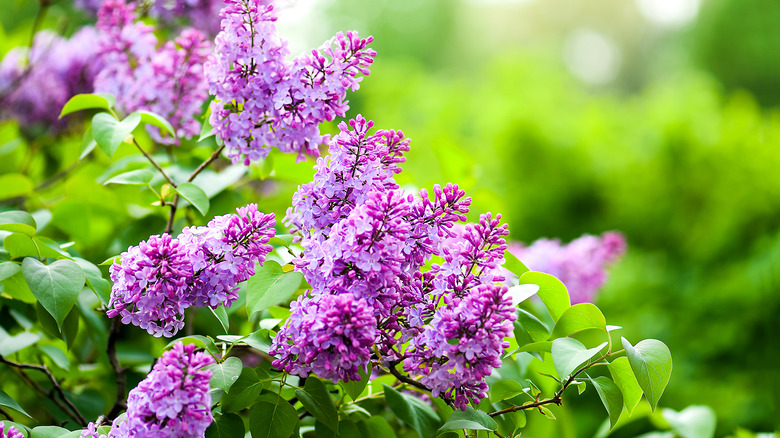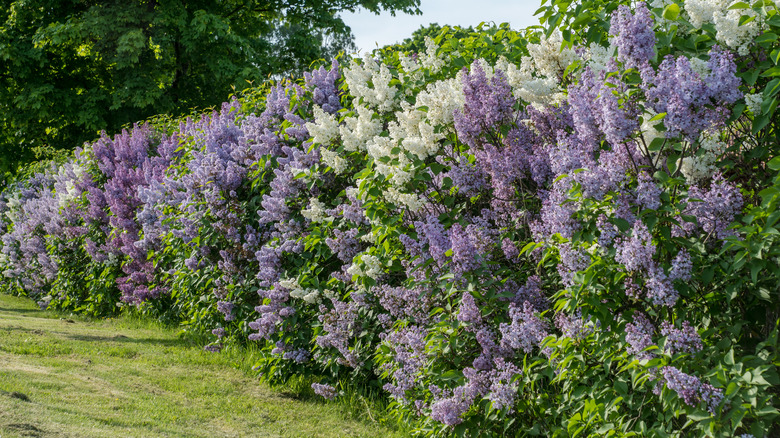Everyone loves lilacs; they are a beautiful flowering bush that makes any garden smell nice. It’s easy to see why so many people want to add lilacs to their outdoor spaces: their beautiful flowers and sweet scent. But putting lilac bushes in the right place and leaving enough space between them is important for their health and performance. How far away from a fence or other structure you plant lilacs is an important thing to think about.
This full guide will tell you everything you need to know about the best distance between lilacs, such as:
- Ideal distance from fences
- Planting tips near homes
- Avoiding potential issues
- Creative solutions for tight spots
- And much more!
Follow these tips to give your lilacs the room they need to grow and thrive for years of enjoyment
Factors That Determine Lilac Spacing
When deciding how far to plant lilac bushes from fences, homes, and other garden features, keep these key factors in mind:
Mature Size – Standard lilac varieties can reach over 15 feet tall and wide at maturity. Dwarf types may max out at just 4-6 feet. Check the expected height and spread for your variety.
Air Circulation – Good airflow is essential to prevent powdery mildew and other fungal diseases. Avoid cramming lilacs tight to structures.
Sun Exposure – Lilacs require full sun to bloom properly. Planting too close to buildings can overly shade the plant.
Root Space – Give lilac roots ample room to spread out through the soil without competing for resources.
Accessibility – Leave enough space around lilacs for pruning, training, and flower harvesting.
Accounting for these factors will provide healthy growing conditions and prevent conflicts with structures as your lilacs reach their mature dimensions.
Recommended Distances from Fences
When incorporating lilacs along backyard fences, follow these spacing guidelines:
-
For standard lilac varieties, allow 6-8 feet between the shrub and fence.
-
For dwarf lilac varieties, leave 3-4 feet between the plant and fence.
-
For mass lilac plantings, increase distances between plants and fences.
-
Position dwarf lilacs on the ends of borders to prevent overcrowding.
-
Keep at least 2 feet between lilacs and any pathways or drives.
These distances provide enough space for air circulation and light exposure. The room also allows easy access for pruning and plant care without damaging the fence.
Tips for Planting Lilacs Near Houses
Lilacs can grow quite large, so use these tips when placing lilacs close to homes:
-
Allow at least 6 feet between lilacs and house foundations or eaves.
-
Choose dwarf varieties for planting nearer homes.
-
Install root barriers along foundations to prevent damage.
-
Prune regularly to control growth around windows, doors, and siding.
-
Focus on planting lilacs near corners or side garages where they have room.
-
Avoid planting directly under roof overhangs or windows.
As the lilac roots grow, problems like clogged gutters, damp basements, and cracked foundations can be avoided by leaving enough space between them.
Can Lilacs Be Planted Right Against a Fence?
Planting lilacs directly against a fence often causes issues down the road:
-
Branches and foliage overload the fence space.
-
Attached shoots and stems damage fencing when removed.
-
Flowers become hidden behind the fence at maturity.
-
Tight quarters increase humidity and disease.
-
Access for pruning and maintenance is challenging.
While you can try planting dwarf lilacs 1-2 feet from the fence, expect to do frequent pruning to control size. Even then, extremely close quarters are far from ideal.
Problems With Planting Too Close to Fences
When lilacs are planted too close to fence lines, the following problems can happen:
-
New shoots grow through gaps in picket and split rail fences.
-
Branches intertwine with wire and mesh fencing materials.
-
Wind causes whippy branches to rub against and loosen fencing.
-
Dense foliage prevents air movement and light, promoting rot of wood posts and boards over time.
-
Growth quickly overtakes the fence making pruning difficult or impossible.
To avoid these issues, allow ample space for air flow based on the expected mature size of your variety.
Clever Solutions for Fitting Lilacs in Small Spaces
For gardens with limited room, get creative with these space-saving ideas:
-
Select dwarf lilac varieties that stay under 5 feet tall.
-
Grow lilacs in large planters that can be moved as needed.
-
Prune and train growth rigorously to dictate size and direction.
-
Support cut lilac branches on small trellises away from fences.
-
Focus on lilacs for central beds rather than cramming along fences.
With the right cultivar choice and care, you can find room for lilacs even in tight garden spaces.
Takeaway
Lilacs require sufficient spacing from fences, homes, and other landscape features to grow freely to their mature dimensions. Crowding leads to disease, dieback, and potentially costly structural damage.
Review the recommended distances and planting tips outlined above when siting lilacs in your own yard. With adequate room, these beloved bloomers will enhance your garden with carefree beauty for years to come.

How to grow lilacs

Lilacs are typically planted in the fall from a sucker (also known as an offshoot) or a transplant bought directly from a plant nursery. The former is essentially a weed-like shoot that sprouts up from the base of the plant and is connected to the root system, per Flower Patch Farmhouse. You will need to dig up the shoot in order to plant it in another location, taking care to catch the roots embedded within the earth as you do so. The more shoots you collect, the better the chances that one will survive once planted and grow into a full lilac bush. Once youve dug up a few, place them in a container of water. Next, youll need to dig a hole deep enough to plant the sucker so it stands up straight. Fill it in with soil and keep it well-watered until it gets established. Keep in mind that suckers take a few years to become full-grown bushes.
A transplanted lilac shrub is one that is grown in a container and is typically well established when you purchase it from a nursery, according to Almanac. You can also find transplants with their root systems wrapped in burlap. Its very simple to plant this type of lilac in your garden. You should first dig a hole deep enough to accommodate the entire root ball and then cover it completely with soil. The area around the roots should be well packed with soil.
How to use lilacs in garden

As lilacs grow in bushes, its best to plant them in areas of your garden that will serve as borders. For instance, planting them along a fence or the side of your house gives you privacy and makes your yard look nicer at the same time. Since this flower is also known for its delicious fragrance, planting them where you are likely to pass frequently, such as near an entryway to your home or lining a pathway, will allow you to enjoy their scent every time you walk by. Additionally, it may also be a good idea to choose a specific variety of lilac for your garden based on its size. A more compact species can be placed on its own in a corner of your yard while larger varieties can serve as a focal point in the center.
People who garden should put lilacs near other flowering shrubs, preferably ones that bloom at different times, according to SF Gate. This will maximize the amount of time you get to see your garden in full bloom during the growing season while also adding a bit of texture to the scene. Some of the best companion plants for lilacs include flowering dogwoods, magnolias, flowering cherries, peonies, and conifers, according to Gardenia. When you plant around your lilacs, be creative with the colors of their blooms to make your backyard look especially beautiful.
Lilac privacy fence
FAQ
Can you plant a lilac bush next to a fence?
Gardeners often focus on growing flowers in containers and in beds. But sometimes we forget that flowering vines can be used to cover bare walls and fences with flowers. This can make a wall look beautiful. One of my favorites is purple lilac vine.
Where should you not plant lilac bushes?
-
Wet Soil:Lilacs are intolerant of soggy conditions and will not thrive in areas where the soil remains wet for extended periods, even if the soil is well-drained otherwise.
-
Excessive Shade:Lilacs require at least 6 hours of direct sunlight per day to flower properly. Planting them in shaded areas will result in fewer blooms and may increase the risk of fungal diseases.
-
Hot, Humid Climates:Lilacs are not well-suited for hot, humid environments, especially those above USDA Hardiness Zone 8. High humidity can contribute to the spread of fungal diseases, and the heat may stress the plants.
-
Other Considerations:
- Lilacs can be planted in containers if needed, but they still require a sunny location and well-drained soil.
- Lilacs can tolerate temperatures well below freezing, but they prefer protection from cold winds that can damage flower buds and stems.
- While lilacs have relatively shallow roots, it’s generally recommended to plant them at least 10 feet away from buildings to avoid potential damage.
- Lilacs can be planted in containers if needed, but they still require a sunny location and well-drained soil.
How far away from a house should you plant a lilac bush?
Lilac roots generally spread one and one-half times the width of the shrub. A distance of 12 feet (4 m. ) from the foundation is generally enough to prevent foundation damage.
How close to plant lilacs for a hedge?
- Smaller varieties: May be spaced 5-8 feet apart for a denser hedge.
- Larger varieties (like common lilac, Syringa vulgaris): May need 10-12 feet or more to ensure adequate space for growth and air circulation.
- Consider desired density: Planting closer together will create a denser, more immediate hedge, but will require more pruning to maintain shape.
- Sunlight and growing conditions: Lilacs need at least 6 hours of direct sunlight to thrive and flower well.
- Soil: Ensure the planting area has well-drained, alkaline soil. Adding lime can help maintain the soil’s pH.
- Pruning: Regular pruning is essential for maintaining the shape and size of the hedge.
